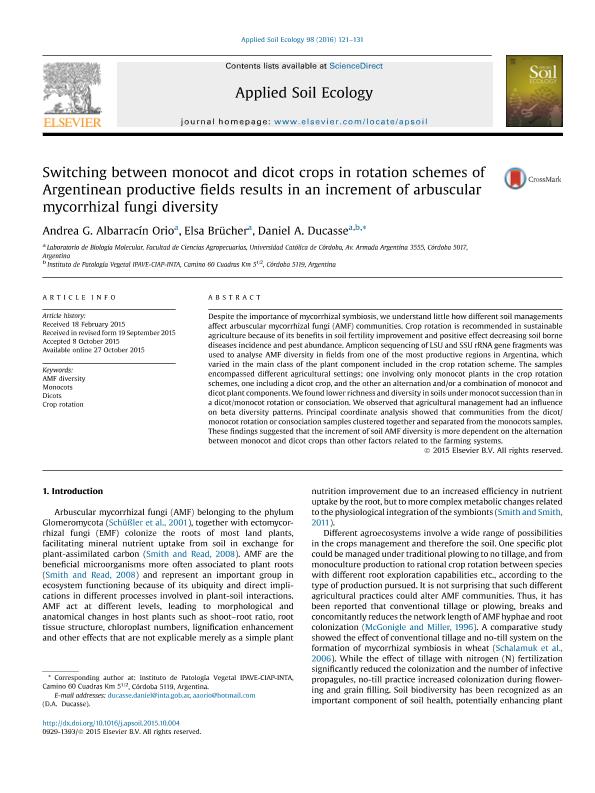Mostrar el registro sencillo del ítem
dc.contributor.author
Albarracín Orio, Andrea Georgina

dc.contributor.author
Brücher, Elsa

dc.contributor.author
Ducasse, Daniel Adrián

dc.date.available
2022-11-30T17:44:14Z
dc.date.issued
2016-02
dc.identifier.citation
Albarracín Orio, Andrea Georgina; Brücher, Elsa; Ducasse, Daniel Adrián; Switching between monocot and dicot crops in rotation schemes of Argentinean productive fields results in an increment of arbuscular mycorrhizal fungi diversity; Elsevier Science; Applied Soil Ecology; 98; 2-2016; 121-131
dc.identifier.issn
0929-1393
dc.identifier.uri
http://hdl.handle.net/11336/179593
dc.description.abstract
Despite the importance of mycorrhizal symbiosis, we understand little how different soil managements affect arbuscular mycorrhizal fungi (AMF) communities. Crop rotation is recommended in sustainable agriculture because of its benefits in soil fertility improvement and positive effect decreasing soil borne diseases incidence and pest abundance. Amplicon sequencing of LSU and SSU rRNA gene fragments was used to analyse AMF diversity in fields from one of the most productive regions in Argentina, which varied in the main class of the plant component included in the crop rotation scheme. The samples encompassed different agricultural settings; one involving only monocot plants in the crop rotation schemes, one including a dicot crop, and the other an alternation and/or a combination of monocot and dicot plant components. We found lower richness and diversity in soils under monocot succession than in a dicot/monocot rotation or consociation. We observed that agricultural management had an influence on beta diversity patterns. Principal coordinate analysis showed that communities from the dicot/monocot rotation or consociation samples clustered together and separated from the monocots samples. These findings suggested that the increment of soil AMF diversity is more dependent on the alternation between monocot and dicot crops than other factors related to the farming systems.
dc.format
application/pdf
dc.language.iso
eng
dc.publisher
Elsevier Science

dc.rights
info:eu-repo/semantics/openAccess
dc.rights.uri
https://creativecommons.org/licenses/by-nc-sa/2.5/ar/
dc.subject
AMF DIVERSITY
dc.subject
CROP ROTATION
dc.subject
DICOTS
dc.subject
MONOCOTS
dc.subject.classification
Otras Ciencias Agrícolas

dc.subject.classification
Otras Ciencias Agrícolas

dc.subject.classification
CIENCIAS AGRÍCOLAS

dc.title
Switching between monocot and dicot crops in rotation schemes of Argentinean productive fields results in an increment of arbuscular mycorrhizal fungi diversity
dc.type
info:eu-repo/semantics/article
dc.type
info:ar-repo/semantics/artículo
dc.type
info:eu-repo/semantics/publishedVersion
dc.date.updated
2022-11-30T12:03:41Z
dc.journal.volume
98
dc.journal.pagination
121-131
dc.journal.pais
Países Bajos

dc.journal.ciudad
Amsterdam
dc.description.fil
Fil: Albarracín Orio, Andrea Georgina. Area de Ciencias Agrarias, Ingeniería, Ciencias Biológicas y de la Salud de la Universidad Católica de Córdoba; Argentina. Consejo Nacional de Investigaciones Científicas y Técnicas. Centro Científico Tecnológico Conicet - Córdoba; Argentina
dc.description.fil
Fil: Brücher, Elsa. Universidad Catolica de Córdoba. Facultad de Cs.agropecuarias. Cátedra de Fitopatologia; Argentina. Consejo Nacional de Investigaciones Científicas y Técnicas. Centro Científico Tecnológico Conicet - Córdoba; Argentina
dc.description.fil
Fil: Ducasse, Daniel Adrián. Area de Ciencias Agrarias, Ingeniería, Ciencias Biológicas y de la Salud de la Universidad Católica de Córdoba; Argentina. Instituto Nacional de Tecnología Agropecuaria; Argentina
dc.journal.title
Applied Soil Ecology

dc.relation.alternativeid
info:eu-repo/semantics/altIdentifier/doi/http://dx.doi.org/10.1016/j.apsoil.2015.10.004
dc.relation.alternativeid
info:eu-repo/semantics/altIdentifier/url/https://www.sciencedirect.com/science/article/abs/pii/S0929139315300974
Archivos asociados
